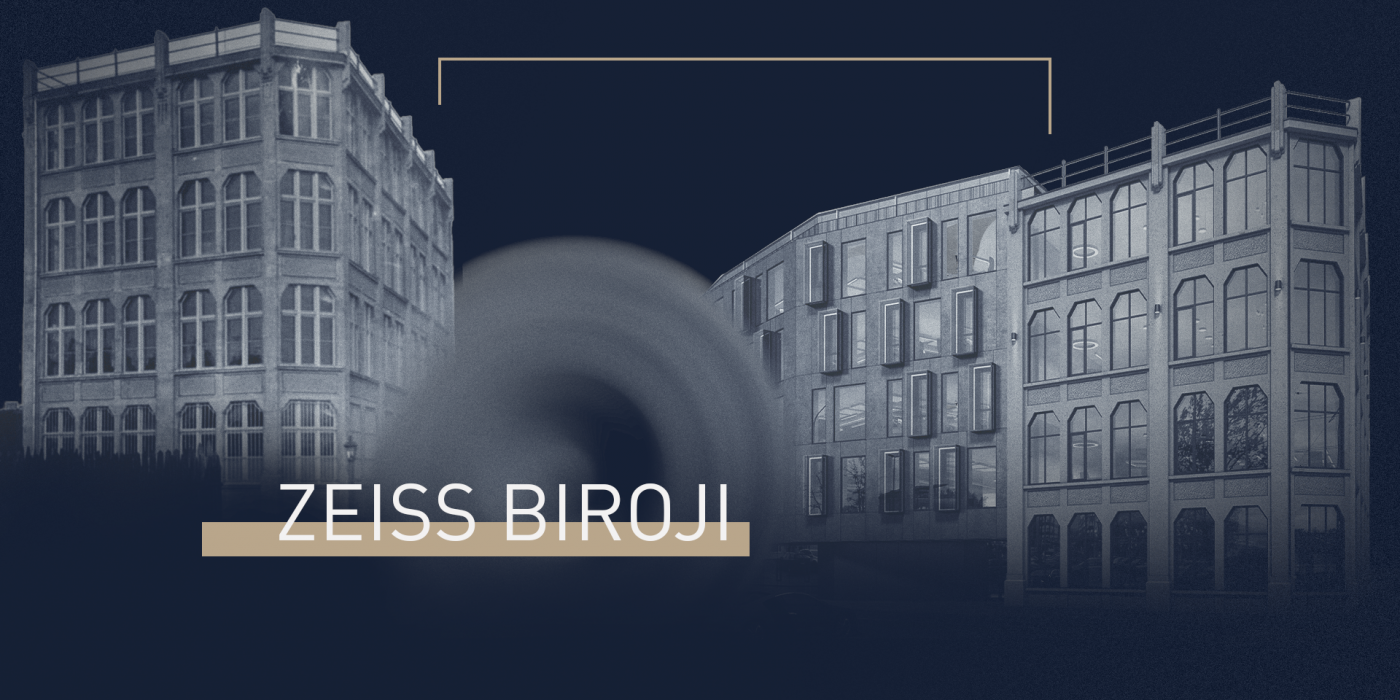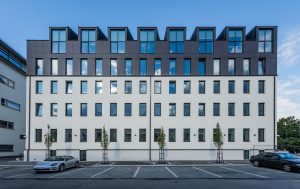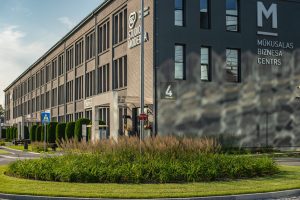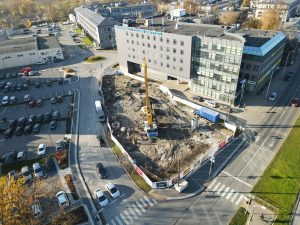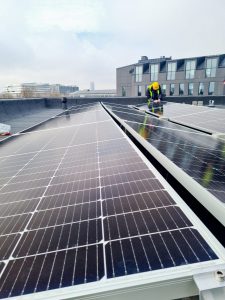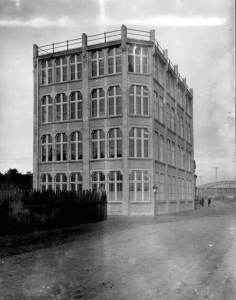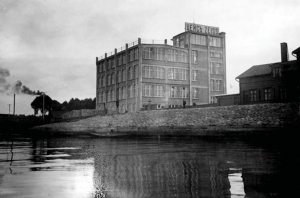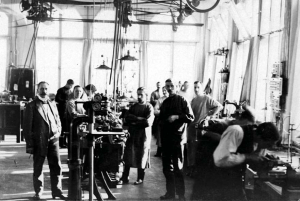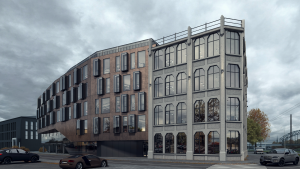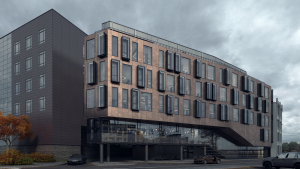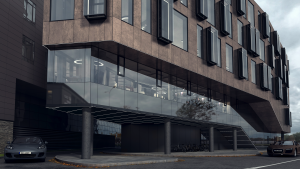Any person who works in the creative industries will agree that history is a powerful source of inspiration. We have better tools, instruments, and solutions than ever before, but that does not mean that we are turning our backs on things that have not only survived through the ages but have also become iconic. This is how the story of ZEISS OFFICES – an upcoming Class A office building in MŪKU SALA – begins. Why was this building given such a name? What is the source of its historical inspiration? And why did it take almost two decades to get this project off the ground?
20 years of development
Development is the measure of not only the prospects of the territory, but also of the growth of society. In recent years, several neighbourhoods of Riga have experienced unprecedented prosperity - neglected or long forgotten areas have now become cultural and business centres, and this development is based on the well-being of the city's inhabitants.
The territory adjacent to Mūkusalas Street has also experienced such a development. Historically, it has been an industrial territory for the last several centuries - factories were created here starting with the 19th century, and this trajectory was largely dictated by the location - the proximity of the Daugava and the historical centre of the city. Times are changing, but not the benefits of Mūkusala - its location is still an extremely attractive feature.
The building of the National Library of Latvia and the Academic Centre of the University of Latvia are not the only milestones in the development of “the near Pārdaugava”. Among these projects are also the forthcoming reconstruction of the Daugava promenade of the left bank and the territory of MŪKU SALA - an environment created for business and leisure, the development of which has been active for the last 20 years, and the result is obvious - such well-known companies as Delfi, Bolt, Tele2, Cognizant, and many other market leaders in their industries now reside here. However, it is not over yet - other significant projects are currently being planned and implemented here, the first of which is “ZEISS OFFICES” - a Class A office building that combines modern solutions and the historical aura of MŪKU SALA.
To develop a new vision
The claim that the origins of the building of ZEISS OFFICES can be traced back to 1912 is not far from the truth, as it was at this time that the Karl Zeiss optics factory was built, and this building has become the main source of inspiration for the new office building. And there is more than the name itself to show for it.
“In 2008 we were invited to provide our vision of the development of Mūkusala Business Centre. And, when coming here to present our ideas, the historic Zeiss building always attracted my attention, as it was completely different from other industrial projects built in Riga,” says Pēteris Bajārs, the leading architect of Outofbox. He was the person who can now be considered the one to come up with the idea of a ZEISS OFFICES building. At that time, representing the architectural firm India, he started researching the building of the historic Zeiss factory – the vision of the Class A office building was largely based on this historical building.
“Even before that, there was a project where one of the solutions was to demolish the building. There was also a solution where a part of the building was to be preserved, and another option, to only keep the façade,” he says. “We tried for a long time to diplomatically convince everyone, that something more could definitely be done with this building, and we asked for the opportunity to give our vision. And then we tried to do it,” says Pēteris Bajārs.
The surprising history
Although the historic Zeiss building, which once stood in the place of the current entrance to Dēļu Street, has been an iconic part of the landscape of Mūkusalas Street for a hundred years, there was very little information about its origins. "Only the executive drawings of 1938 have survived and were available at the Riga City Construction Board, but there was no information about the building itself. In our offer, we promised to do a thorough research and get all the information about this building - everything we could get,” says the author of the idea of ZEISS OFFICES. "Then we “dug” until we found out that it was once a Karl Zeiss optics factory. While searching for other Karl Zeiss factories, a colleague found a postcard from Jena, Germany, where Carl Zeiss' main factory is located. And this building had a lot in common with the building in Riga, which in turn encouraged us to write to the Carl Zeiss archive,” he says.
This decision was a success - although it is not known who designed the building, the architect's office learned that it was built in 1912 as a monolithic reinforced concrete building that would essentially make it the oldest reinforced concrete building in Riga - now the oldest building of its kind is the Splendid Palace cinema, built in 1923. So, it turned out that the Carl Zeiss's historic factory building were the proud owners of this title even 11 years earlier.
“The other interesting thing was that the façades of the building consisted of monolithic reinforced concrete, but the façades on both ends were like temporary brickwork, with the idea that the building could be built in stages as a Lego house. This is what happened in Jena, where the building occupies a whole block. But here, with the beginning of the First World War in 1914, all production was stopped,” says the architect.
After the war, the Zeiss optics factory did not resume production. But what happened to the equipment that was left in the building? Pēteris Bajārs has also found the answer to this question. "The equipment was taken to Novosibirsk, where there is still an optics factory. And as far as we gathered, it still uses the same equipment.”
Seven different ideas
The road from the idea to the implementation of the project has truly been long, but in January 2022, the official ceremony during which the time capsule was buried, finally took place. The words of Klāvs Vasks, the co-owner of Mūkusala Business Centre, serve as a reminder of how long this project has taken: “This is the longest project of my life. During this time, my two daughters have grown up, one of them has already graduated from university, and we have built at least four other buildings in the area. But my message is that everyone needs a goal. And if you believe in this goal, move towards it and do not give up, sooner or later the result will be achieved,” he said during the official ceremony.
According to him, seven different architects have been involved throughout the project and seven different ideas have been developed about what the ZEISS OFFICES building should look like. And due to various circumstances, Pēteris Bajārs, although the author of the idea for the office building, is now watching the construction of the building from the sidelines.
"There was an economic crisis in the middle of the project, so there was a break. We resumed work on the project in 2014, but by the time the project was confirmed, it was revealed that the Zeiss building had been empty and in a dramatic condition since the 1990s. In fact, maintaining it was economically unreasonable,” says Pēteris Bajārs. "It was decided to demolish the building and build a copy in its place. Mūkusala Business Centre offered us this work, but we did not want to create a copy, so we decided not to continue working on the project,” he says.
Based on the sketches and technical design developed by the architectural firm India, the work was continued by DUAL architects, and construction work is currently being carried out by the construction company Velve. However, the connection between Pēteris Bajārs and MŪKU SALA has not been broken - he has also designed other buildings for this area and developed a renewed vision of the quarter.
Free from the nihilism of industrialization
Plans have changed over time, but the overall development is undeniable - in recent years, Dēļu Street, which had disappeared from the map of Riga for some time, was rebuild, plans for a pedestrian bridge that will connect MŪKU SALA with the Torņakalns neighbourhood are also underway. “We have regained the things that the Soviet years and the absolute nihilism of industrialization had destroyed. The ZEISS OFFICES building represents the highest quality architecture, different and visible, and it serves as a business card for the Mūkusala Business Centre, and I hope that this will be the case in the future," says the author of the idea of ZEISS OFFICES.
"The process has been very interesting; the process has been very long. And, of course, a lot has happened along the way, but it is gratifying that the steps that had been taken are being continued consistently. It seems to me that we were on the right track, as shown by the fact that in 2022 we are building a building whose first sketches were made in 2008 and that these sketches have been very contemporary. And they still are contemporary.”

